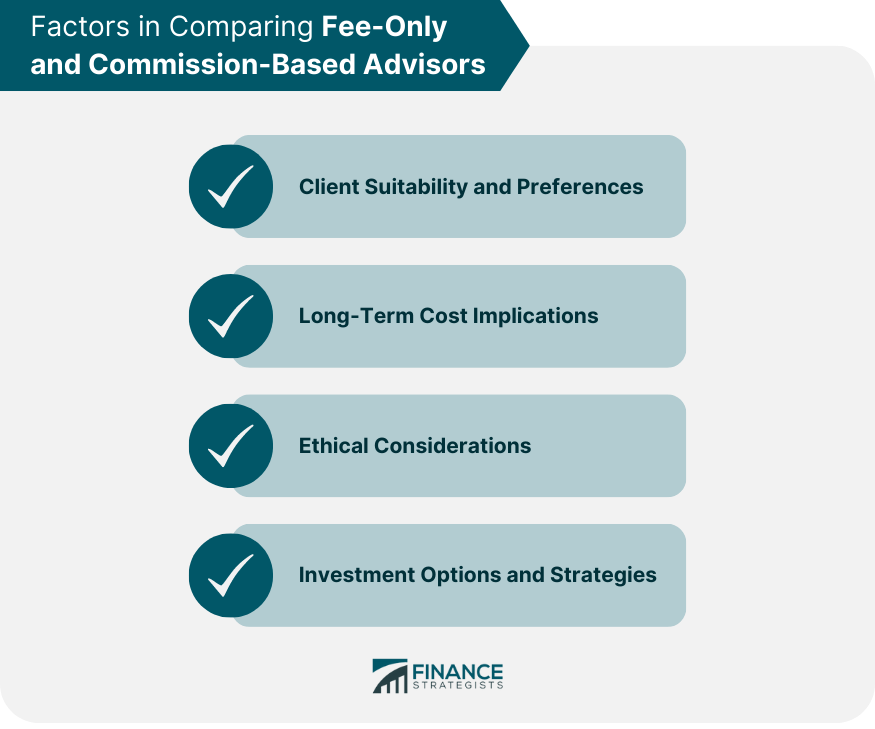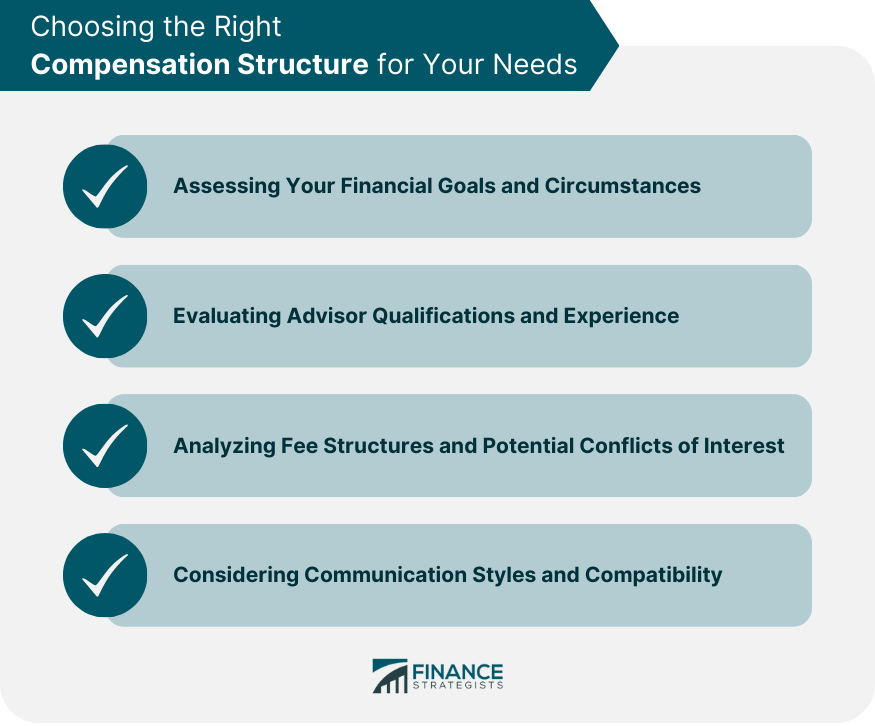When seeking financial advice, it is essential to understand the difference between fee-only and commission-based compensation structures. Both structures have their unique advantages and disadvantages, and choosing the right one for your needs is crucial in securing your financial future. Understanding the differences between fee-only and commission-based compensation can help you make informed decisions when selecting a financial advisor, ensuring that you receive unbiased and competent advice tailored to your financial goals. Fee-only financial advisors receive compensation solely through fees paid directly by their clients. These fees can be charged hourly, as a flat fee, or as a percentage of assets under management. Fee-only advisors do not receive commissions or other incentives tied to the sale of investment products. Fee-only advisors are required to act as fiduciaries, meaning they must put their clients' best interests ahead of their own. This responsibility ensures that clients receive recommendations based on their unique needs and objectives, rather than on the advisor's potential financial gain. Since fee-only advisors do not receive commissions or incentives tied to specific financial products, they face fewer conflicts of interest when making recommendations. The fee-only compensation structure offers greater transparency and simplicity, as clients can easily understand how their advisor is being paid. Fee-only advisors may be more expensive for clients who require limited financial advice or engage in infrequent transactions, as they typically charge fees regardless of the number of transactions made. Commission-based financial advisors earn compensation through commissions on the sale of investment products and services to clients. They may work for brokerage firms, insurance companies, or other financial institutions and receive a percentage of the sales price or a flat fee for each financial product or service they sell. Commission-based advisors may be more cost-effective for clients who engage in infrequent transactions or require limited ongoing financial advice, as they only pay a commission for each transaction made. Commission-based advisors often have access to a diverse selection of investment products and services, which can provide clients with a wide range of options to meet their financial goals. Since commission-based advisors earn compensation based on the products they sell, they may be more motivated to recommend investments that perform well and help clients achieve their financial objectives. Commission-based advisors may face conflicts of interest when recommending financial products and services, as they may be incentivized to recommend options that generate higher commissions rather than those that are in the client's best interest. Unlike fee-only advisors, commission-based advisors are typically held to a "suitability" standard, meaning they must only recommend investments that are suitable for the client's needs and objectives, rather than the best available options. When selecting a financial advisor, consider your financial goals, investment preferences, and the level of ongoing advice you require. Evaluate the advantages and disadvantages of fee-only and commission-based advisors to determine which compensation structure best aligns with your needs. Consider the long-term cost implications of each compensation structure, taking into account the fees and commissions associated with your investment strategy and the potential impact on your overall financial goals. Assess the ethical implications of each compensation structure, including the potential conflicts of interest and fiduciary responsibilities associated with fee-only and commission-based advisors. Evaluate the range of investment products and strategies offered by fee-only and commission-based advisors, ensuring that the advisor you choose can provide the appropriate options to meet your financial objectives. Before selecting a financial advisor, take the time to assess your financial goals and circumstances. This process will help you determine which compensation structure is best suited to your needs and objectives. Consider the qualifications and experience of potential advisors, ensuring that they have the necessary expertise in financial planning and investment management to help you achieve your financial goals. Analyze the fee structures of potential advisors and identify any potential conflicts of interest arising from their compensation models. By doing so, you can ensure that you select an advisor who is motivated to act in your best interest. Evaluate the communication styles of potential advisors and consider whether their approach is compatible with your preferences. An advisor who communicates effectively and is willing to work closely with you is more likely to help you achieve your financial goals. Understanding the differences between fee-only and commission-based compensation structures is essential when selecting a financial advisor, as the right choice can significantly impact your financial well-being and the achievement of your financial goals. Each compensation structure has its unique advantages and disadvantages, and it is crucial to carefully consider your personal financial goals and circumstances when making a decision. Evaluating the qualifications, experience, and fee structures of potential advisors will help you select the most suitable advisor to help you secure your financial future. By taking the time to analyze the pros and cons of fee-only and commission-based compensation structures, you can make an informed decision that aligns with your needs and objectives. This process will ensure that you receive competent and unbiased financial advice tailored to your unique financial goals, ultimately helping you achieve long-term financial success.Fee-Only vs Commission-Based Compensation: Overview
Fee-Only Compensation
Definition and Structure
Pros and Cons
Fiduciary Responsibility
Conflict of Interest Reduction
Transparency and Simplicity
Potential Cost Concerns
Commission-Based Compensation
Definition and Structure
Pros and Cons
Potential Cost Savings for Certain Clients
Access to a Wide Range of Investment Products
Incentives for Advisor Performance
Potential Conflicts of Interest
Limited Fiduciary Responsibility
Factors in Comparing Fee-Only and Commission-Based Advisors
Client Suitability and Preferences
Long-Term Cost Implications
Ethical Considerations
Investment Options and Strategies

Choosing the Right Compensation Structure for Your Needs
Assessing Your Financial Goals and Circumstances
Evaluating Advisor Qualifications and Experience
Analyzing Fee Structures and Potential Conflicts of Interest
Considering Communication Styles and Compatibility

Conclusion
Fee-Only vs Commission-Based Compensation FAQs
Fee-only compensation is a financial advisor compensation model in which the advisor charges a set fee for their services, and does not receive any commissions or other compensation from the sale of financial products. The fee can be a flat fee, hourly rate, or a percentage of assets under management.
Commission-based compensation is a financial advisor compensation model in which the advisor earns a commission on the financial products they sell to clients. The commission amount is typically a percentage of the total amount invested or the premium paid for an insurance policy.
One advantage of fee-only compensation is that it eliminates conflicts of interest that may arise with commission-based compensation. Fee-only advisors do not receive commissions from the sale of financial products, so they are not incentivized to recommend products that may not be in the client's best interest. Additionally, fee-only advisors typically provide ongoing advice and financial planning services, since their income is not based on selling products.
One advantage of commission-based compensation is that there are typically no upfront fees or charges for the advisor's services. Instead, the advisor earns a commission on the financial products they sell, which may be more affordable for clients who cannot afford to pay a fee-based advisor. Additionally, commission-based advisors may have access to a wider range of financial products and services.
The best compensation model for you depends on your individual needs and preferences. If you prefer a comprehensive financial planning approach and want to avoid conflicts of interest, a fee-only advisor may be the best choice. If you are primarily interested in buying financial products and want to minimize upfront costs, a commission-based advisor may be the best choice. It is important to do your research and select an advisor who is transparent about their compensation structure and has a fiduciary duty to act in your best interests.
True Tamplin is a published author, public speaker, CEO of UpDigital, and founder of Finance Strategists.
True is a Certified Educator in Personal Finance (CEPF®), author of The Handy Financial Ratios Guide, a member of the Society for Advancing Business Editing and Writing, contributes to his financial education site, Finance Strategists, and has spoken to various financial communities such as the CFA Institute, as well as university students like his Alma mater, Biola University, where he received a bachelor of science in business and data analytics.
To learn more about True, visit his personal website or view his author profiles on Amazon, Nasdaq and Forbes.















